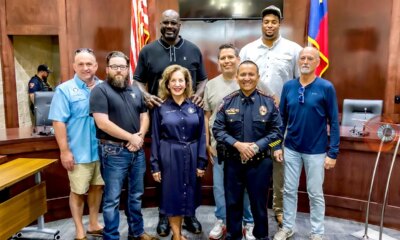Culture
Will the best Celtics player please rise? There's a long list of nominees after Game 2 win

BOSTON — Considering his 26-point, 11-rebound effort in the Celtics’ 105-98 victory in Game 2 of the NBA Finals Sunday night, does that now make Jrue Holiday Boston’s best player?
Or, with Derrick White meeting P.J. Washington at the rim and making a stunning block of a would-be running dunk with 50.5 seconds remaining to keep the Mavericks from closing to within three points, does that transform White into Boston’s finest?
We are, after all, living in an NBA postseason in which recency bias has become a thing. For that, stick tap to Mavericks coach Jason Kidd, who is playing head games while everybody else is just trying to play basketball. His twice-said Saturday comment that Jaylen Brown is the Celtics’ best player created quite a stir but also opened up a runway for the recency bias crowd to put it out there that, well, Brown did emerge as MVP of the Eastern Conference finals. And that, went the goofy logic, meant Brown, and not Jayson Tatum, is Boston’s “best” player.
GO DEEPER
How Celtics took command of NBA Finals with Game 2 win over hurting Mavs
And now, while mulling all that, consider what happened after Game 2 Sunday night when Celtics coach Joe Mazzulla arrived in the interview room for his postgame news conference. The first question had something to do with Tatum, but Mazzulla instead pivoted to what happened on the last possession of the third quarter when Payton Pritchard, who had just entered the game in place of Holiday, raced up the court and delivered a 34-foot buzzer-beating bank shot to give the Celtics an 83-74 lead.
Proclaiming it “the play of the game,” Mazzulla noted that “you see guys around the league pass up on that shot or fake like they want to take it, so that their numbers don’t get messed up. He takes pride in taking that, and that’s winning basketball.”
Free, daily sports updates direct to your inbox. Sign up
Free, daily sports updates direct to your inbox. Sign up
Buy
Mazzulla didn’t stop there. “That first and foremost should have been the first question,” he said. “The ability of everybody on our team to do different things that lead to winning.”
Mazzulla then went here: “I’m really tired of hearing about one guy or this guy or that guy and everybody trying to make it out to be anything other than Celtic basketball. Everybody that stepped on that court today made winning plays on both ends of the floor, (and that’s) the most important thing.”
What an exchange. It began with a question about Tatum that tuned into an answer about a 3-pointer by Pritchard, and it ended with Journalism Joe explaining which question should have been batting leadoff. It was goofy, sure, but it was absolutely brilliant in that it had the effect of turning Kidd’s comment about Jaylen Brown into an exploding cigar.

Jrue Holiday’s 26-point, 11-rebound effort in Game 2 was foremost among many great performances for the Celtics. (Peter Casey / USA Today)
Such was the Celtics’ across-the-board effort in Game 2 that it became folly to proclaim this or that player Boston’s top performer. You could have gone with Holiday because of the 26 points. You could have gone with White because of the block. But wait! If Mazzulla had had his way, Pritchard would have been extra, extra, read all about it. And as if anyone needed yet more evidence that Kidd really stepped in it with his attempt to bring a little discord to the Celtics locker room, consider how Holiday conducted his affairs at his postgame conference.
With Mazzulla, it was all about telling the media people what the first question should have been. With Holiday, it was all but providing an answer before a question had even been asked.
First, some background. On Saturday, Holiday was asked if he had any thoughts on Kidd’s remark about Brown and replied, “I don’t think he’s lying.” Which was taken to mean he agreed with Kidd’s remark.
When he arrived in the interview room after Game 2, Holiday got right down to business.
“If I could say something before we jump in, I want to address the comment that was made yesterday,” he began. “I feel like people kind of took that out of context. I’ve been hearing that I prefer JB over JT, and that’s not what that was. I like to praise my teammates. I like to praise my teammates when they’re playing well, and I feel like that’s what I did my best to do.”
He went on to say that “… to compare them is something that I would never do because they’re two completely different players as well as being on the same team, and the things that they have done in this organization and the things that they have done against me as an opponent, I say, like, how they play together and how they work together is something that is sacred and something that can’t be broken.”
GO DEEPER
Jason Kidd’s challenge to ‘sacred’ Brown-Tatum partnership fuels Celtics’ Game 2 win
What’s interesting about all this — no, make that what’s amazing about all this — is that last season ended with Celtics president of basketball operations Brad Stevens practically being delivered a mandate to build a better team and not rely on the dazzling talents of Tatum and Brown to deliver a championship. And by trading Marcus Smart and bringing in Kristaps Porzingis and Holiday, it’s safe to say Stevens did indeed build a better team. The Celtics’ best-of-show 64-18 regular-season record will attest to that.
But if you want to talk team, and not just from the perspective of how the roster looks but also from the perspective of its character and soul, consider how the Celtics countered Kidd.
Brown and Tatum essentially stayed out of it. Holiday submitted a scrapbook playoff performance and then opened his postgame presser with Holiday’s Soliloquy, during which he spoke emotionally about his feelings for Tatum and Brown, and the camaraderie that’s taking place in the room.
And then there was Joe Mazzulla in the role of Perry White, editor of the Metropolis Daily Planet, deciding what’s news and what isn’t.
Never in the Tatum-Brown/Brown-Tatum era have the Celtics been more of a team than they were Sunday night.
(Top photo of Jaylen Brown: Maddie Meyer / Getty Images)

Culture
Do You Know the Notable Buildings Mentioned in These Books?

A strong sense of place can deeply influence a story, and in some cases, the setting can even feel like a character itself. This week’s literary geography quiz highlights buildings that inspired authors, often to the point of including the structures in their novels. (Many of the buildings are still open to visitors.) To play, just make your selection in the multiple-choice list and the correct answer will be revealed. At the end of the quiz, you’ll find links to the books if you’d like to do further reading.
Culture
Video: 250 Years of Jane Austen, in Objects

new video loaded: 250 Years of Jane Austen, in Objects
By Jennifer Harlan, Sadie Stein, Claire Hogan, Laura Salaberry and Edward Vega
December 18, 2025
Culture
Try This Quiz and See How Much You Know About Jane Austen

“Window seat with garden view / A perfect nook to read a book / I’m lost in my Jane Austen…” sings Kristin Chenoweth in “The Girl in 14G” — what could be more ideal? Well, perhaps showing off your literary knowledge and getting a perfect score on this week’s super-size Book Review Quiz Bowl honoring the life, work and global influence of Jane Austen, who turns 250 today. In the 12 questions below, tap or click your answers to the questions. And no matter how you do, scroll on to the end, where you’ll find links to free e-book versions of her novels — and more.
-

 News1 week ago
News1 week agoFor those who help the poor, 2025 goes down as a year of chaos
-

 Detroit, MI4 days ago
Detroit, MI4 days ago2 hospitalized after shooting on Lodge Freeway in Detroit
-

 Dallas, TX3 days ago
Dallas, TX3 days agoDefensive coordinator candidates who could improve Cowboys’ brutal secondary in 2026
-

 Southeast1 week ago
Southeast1 week agoMurder in small-town America: The crimes that tore quiet communities apart in 2025
-

 Technology2 days ago
Technology2 days agoPower bank feature creep is out of control
-

 Midwest1 week ago
Midwest1 week agoMcDonald’s locks doors to keep out individuals who present ‘a risk’ in crime-ridden Minneapolis area
-

 West1 week ago
West1 week agoApex predator threatening Northwest salmon sparks rare bipartisan push to ‘kill more’
-

 Southwest1 week ago
Southwest1 week agoMissing 19-year-old Camila Mendoza Olmos believed to be ‘in imminent danger,’ Texas sheriff says

























